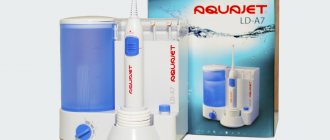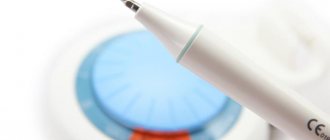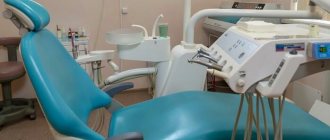An analysis of statistics on purchases of portable irrigators for 2021 from various companies will allow you to choose a high-quality device for maintaining dental health.
When selecting 15 models for the rating, Rostest test results, product functionality, as well as reviews from experts and customers were used.
Rating of the TOP 15 best portable irrigators of 2022
| Place | Name | Price |
| TOP 3 best portable irrigators by price/quality for 2022 | ||
| 1 | WaterPik WP-450 Cordless Plus | Find out the price |
| 2 | B.Well WI-912 | Find out the price |
| 3 | Soocas W3 Pro | Find out the price |
| TOP 3 best bubble portable irrigators | ||
| 1 | Panasonic EW1211A | Find out the price |
| 2 | Oral-B Aquacare 4 | Find out the price |
| 3 | Philips AirFloss HX8261/01 | Find out the price |
| TOP 3 best pulse portable irrigators | ||
| 1 | B.Well WI-933 | Find out the price |
| 2 | Kitfort KT-2902 | Find out the price |
| 3 | Revyline RL 450 | Find out the price |
| TOP 3 best monojet portable irrigators | ||
| 1 | Rokimed RKM-1701 / RKM-1702 | Find out the price |
| 2 | Philips Sonicare AirFloss Ultra HX8438/03 | Find out the price |
| 3 | Kitfort KT-2906 | Find out the price |
| TOP 3 best portable irrigators with adjustable jet pressure | ||
| 1 | Soocas W3 (4 nozzles) | Find out the price |
| 2 | Revyline RL210 | Find out the price |
| 3 | B.Well PRO-913 | Find out the price |
How to choose a portable irrigator in terms of price/quality ratio?
When purchasing a portable irrigator, special attention should be paid to seven technical characteristics of the device:
- Power source type . Most often, portable irrigators are equipped with lithium or lithium-ion batteries of different capacities. The higher their capacity, the longer the device will not need to be charged. Ideally, the battery capacity should be greater than 1000 mAh. In this case, the irrigator can be used without recharging for about 3–5 days.
- Type of jet delivery . Modern irrigators use one of three types of jet supply:
- pulsating jet - a thin stream of water with a short pulsation is created, thanks to which food debris and plaque are knocked out from the interdental spaces, and a light massage of the gums is also performed;
- microbubble water supply - a stream of water actively mixes with air bubbles, thanks to this a more thorough cleaning of the oral cavity in hard-to-reach places is performed;
- monojet - creates a continuous stream of water jet, which has a stable power.
- Number of operating modes . There can be from 2 to 10. If you have diseases of the oral cavity, it is recommended to choose a model with a large number of modes. Since this will allow more flexible adjustment of irrigation parameters.
- Pulsation frequency . The optimal number of pulsations for a sensitive oral cavity is 1200 pulses per minute. For healthy teeth and gums, you can choose a model with a higher number of pulsations.
- Liquid container size . How often you will need to add water to the tank depends on its volume. To perform one full cleaning procedure, it is better to purchase tanks with a water tank volume of 210 ml or more.
- Number of nozzles . Most irrigators come with a standard jet nozzle. Additionally, the device can be equipped with a useful brush attachment for cleaning the tongue, an attachment for cleaning orthodontic or implant structures.
Instructions for use
When purchasing a portable irrigator in a store or online, you must carefully and carefully study the instructions that come with each model before using it for the first time. You can watch a video review if something is unclear from the manual.
In addition to individual requirements, there are general points that are suitable for any device:
- Before starting work, fill the container with warm tap water.
- Select the desired attachment and install it on the handle.
- Set the water supply to the weakest level.
- Before starting the unit, place the tip in the oral cavity and squeeze it with your lips.
- Lean over the sink and press the power button.
- Start treatment with the upper back teeth, directing the jet down the teeth.
- Move smoothly along the gums, stopping between them to clean every crevice.
- In the same way, go over the back upper teeth and all the lower ones.
- Turn off the device.
- Remove the nozzle and put it in a special mount.
- Pour out any remaining water from the reservoir.
Don't forget about periodically changing heads. This is necessary to maintain hygiene and dental health. By following these simple rules, you can be sure of long-term operation of the electrical appliance.
TOP 3 best portable irrigators by price/quality for 2022
WaterPik WP-450 Cordless Plus
The WaterPik WP-450 Cordless Plus irrigator has a very compact size, but at the same time it has a sufficient tank volume.
The plastic tank can be filled with water, special antiseptic or medical solutions. The reservoir capacity is sufficient for 45-55 seconds of thorough cleaning of the oral cavity.
The jet pressure is enough to clean teeth from plaque and various types of contaminants, which prevents the development of gum and tooth diseases.
To clean various areas of the oral cavity, the kit includes the following attachments: standard, for cleaning the tongue, orthopedic, professional Plaque Seeker for cleaning implant structures.
The powerful battery allows you to use the irrigator continuously for 20 minutes or with standard use for 5-7 days.
Once the battery is discharged, it can be charged to 100% in 8 hours.
Specifications:
- number of operating modes - 2;
- water pulsation frequency - 1450 imp/min;
- working pressure of the water jet - from 210 to 520 kPa;
- water tank capacity - 210 ml.
pros
high jet power;
long battery life;
high quality materials and workmanship.
Minuses
no charge indicator.
B.Well WI-912
The B.Well WI-912 portable irrigator is powered by a lithium-ion battery, the resource of which is enough for 500 operating cycles without reducing the battery capacity.
When fully charged, the battery allows the irrigator to operate continuously for up to 60 minutes. To charge the irrigator, a contactless charger is included in the package.
Thorough cleaning of the oral cavity is ensured by three modes of operation of the irrigator: Normal - designed for effective cleaning of teeth in the standard mode, Soft - used to clean the interdental spaces in sensitive teeth, Pulse - suitable for massaging the gums.
Five attachments included will allow you to clean your tongue, braces, massage your gums, and also remove plaque and food debris in the interdental space. The manufacturer has provided two standard attachments.
They have multi-colored marks . Therefore, they can be used by two people.
Two buttons on the front of the device allow you to control the operation of the irrigator.
Specifications:
- number of operating modes - 3;
- water pulsation frequency - 1420 imp/min;
- working pressure of the water jet - from 378 to 720 kPa;
- water tank capacity - 150 ml.
pros
rich set of supplies;
the battery holds a charge for a long time;
high water pressure power.
Minuses
very small water tank.
Soocas W3 Pro
The Xiaomi Soocas W3 Pro irrigator has a waterproof body manufactured according to the IPX7 standard.
This design allows you to wash the irrigator under water. Durable plastic makes the device lighter. Therefore, it is convenient to take it on trips.
The built-in battery has a fairly large capacity (2200 mAh), which allows the irrigator to work for 14 days.
Once the battery is completely discharged, it will take a USB cable and about 4-6 hours of time to replenish its charge. An indicator signal on the device body will notify you that charging is complete.
To clean the oral cavity, the functionality of the irrigator provides three modes: “Massage” - a soft pulsation of water to strengthen the gums, “Delicate” - for cleaning sensitive teeth, “Deep cleaning” - the most powerful mode for thoroughly cleansing the teeth.
Standard, periodontal, orthodontic and spoon attachments allow you to thoroughly clean your teeth, interdental spaces, tongue, palate and inner cheeks. A plastic box is included for storing attachments.
Specifications:
- number of operating modes - 7;
- water pulsation frequency - 1300 imp/min;
- working pressure of the water jet - from 138 to 965 kPa;
- water tank capacity - 240 ml.
pros
various attachments included;
a large number of operating modes;
long battery life.
Minuses
The attachments are difficult to remove.
Criterias of choice
According to the type of design, the units are stationary, portable, or water-powered. Stationary units are characterized by large dimensions.
They have several attachments with different color markers, so the whole family can use them. Portable devices are battery powered, they are small in size and have lower water jet pressure. This device is suitable for regular trips. The tap irrigator has the lightest design. The device is simply connected to the tap, and it works due to its pressure. The downside of the system is that it is quite difficult to regulate the water pressure. Based on the type of operation, irrigators are divided into pulse (the safest), microbubble and monojet.
Before purchasing, you need to familiarize yourself with the main criteria for choosing the best irrigator for hygienic cleansing of the mouth:
- Design. For frequent trips and business trips, it is better to focus on a portable device; in other cases, it is recommended to choose stationary irrigators.
- Jet pressure. If you have dental pathologies, it is necessary to choose irrigators with the function of regulating water pressure.
- Power. The optimal power indicators for the device are 250-600 kPa for portable models, 600-900 kPa for stationary and water-pressure models.
- Tank capacity. Normally, the volume of the liquid compartment should be within 600 ml-1 l for stationary structures and 120-250 ml for portable ones.
It is also necessary to pay attention to the configuration of the device. Stationary models can be equipped with 5-10 nozzles for a more detailed study of individual zones, portable and tap ones - 2-4.
TOP 3 best monojet portable irrigators
Rokimed RKM-1701 / RKM-1702
The Rokimed RKM irrigator is available in two varieties: 1701 and 1702.
The models are completely identical in functionality, but differ in appearance. Both types of device have a white body, but differ in the color of the liquid reservoir (blue or pink).
Based on the type of technology used, the device is classified as a constant stream irrigator . It allows you to wash away food debris from hard-to-reach places.
The irrigator is equipped with a lithium battery, which has a fairly long service life. This allows you to use the device for about 45 minutes continuously (in terms of standard use once a day, this is about three months of operation without recharging).
The auto-shutdown function, which is activated when the irrigator is not used for 30 seconds, will reduce battery consumption.
The device is charged using a USB cable for 8 hours.
Specifications:
- number of operating modes - 1;
- water pulsation frequency - 1200 imp/min;
- working pressure of the water jet - from 310 to 520 kPa;
- water tank capacity - 150 ml.
pros
quiet operation;
supply of a powerful jet;
compact dimensions.
Minuses
small tank volume.
Philips Sonicare AirFloss Ultra HX8438/03
The Philips Sonicare AirFloss Ultra portable water flosser removes up to 99.9% of plaque using micro-fine water droplet technology.
It allows you to use water or mouthwash in combination with air flow. This ensures more effective and gentle cleaning of teeth and gums.
Brushing your teeth with this irrigator will take no more than a minute a day . The user simply needs to select the spray frequency (single, double or triple) and hold the button to automatically spray water.
The built-in battery makes the irrigator portable.
It allows you to use the device without connecting to the network for 1–3 weeks. After the irrigator is completely discharged, it will require a long charge of 24 hours.
Specifications:
- number of operating modes - 3;
- water pulsation frequency - 1800 imp/min;
- working pressure of the water jet - from 140 to 800 kPa;
- water tank capacity - 150 ml.
pros
capacious battery;
good quality of cleaning interdental spaces;
compact sizes.
Minuses
leaky design.
Kitfort KT-2906
Portable irrigator Kitfort KT-2906 allows you to effectively clean the oral cavity.
Three different operating modes (Normal, Soft and Pulse) will make it possible not only to remove food debris and plaque from the interdental space, but also to massage the gums to reduce their bleeding.
To allow the device to be used independently of the network, the manufacturer has included a built-in battery in the design . It allows the irrigator to work autonomously from the mains for a long time after being fully charged (within 4 hours).
Two family members can use the irrigator at once thanks to the included two jet nozzles with O-rings of different colors.
Specifications:
- number of operating modes - 3;
- water pulsation frequency - 1400–1800 imp/min;
- working pressure of the water jet - from 200 to 700 kPa;
- water tank capacity - 150 ml.
pros
compact dimensions;
convenient case included;
adjustable jet power.
Minuses
small water tank.
Advantages and disadvantages
The portable oral irrigator is suitable for use even by children. This is a device that is perfect for caring for crowns, braces, dentures, and implants. The main advantages of the devices include the following:
- Mobility. You can take the device with you on a trip. Thanks to its autonomy and small size, it is ideal for travel and will work where there is no power connection.
- Affordable price. Portable models are much cheaper than stationary ones.
- Reducing costs for dental procedures. To remove plaque from teeth, one brush is not enough, so you have to visit the dentist for professional hygiene. The irrigator efficiently removes plaque, cleans the tongue, the oral cavity, and hard-to-reach places between the teeth, so the possibility of plaque formation is minimized.
- Autonomous work. There is no need to connect the product to the network. Charging lasts for a long time.
The device has only one drawback - the small volume of the water tank. If intensive cleaning is required, you will have to refill it several times. For a standard procedure, a volume of 200 ml will be sufficient.
If we talk about which irrigator is better: stationary or portable, there is no clear answer to this question. For people who travel frequently, it is better to purchase an autonomous and miniature device. If you plan to use the device with the whole family and mainly at home, choose a stationary model.
Which company should you choose?
Portable irrigators allow you to take more thorough oral care. The safety of using the device and the quality of teeth cleaning depend on the quality of execution and functionality of the irrigator. Therefore, it is important to choose a proven device.
The most functional and reliable models in 2022, according to customer and expert reviews, are produced by nine companies:
- WaterPik (USA);
- Soocas (China);
- Panasonic (Japan);
- Oral-B (USA);
- Philips (Netherlands);
- Kitfort (China);
- B.Well (Switzerland);
- Rokimed (Russia);
- Revyline (China).
Among the listed manufacturers, Soocas, Kitfort, and Rokimed produce budget models.
In the middle price segment there are portable irrigators from the companies WaterPik, B.Well, Oral-B, Revyline. Premium, more expensive models are produced by Panasonic and Philips.










